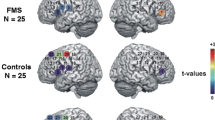Abstract
Purpose
Neuro-imaging studies with 99mTc-HMPAO SPECT in fibromyalgia (FM) patients have reported only limited subcortical hypoperfusion. 99mTc-ECD SPECT is known to provide better evaluation of areas of high cerebral blood flow and regional metabolic rate. We evaluated a homogeneous group of hyperalgesic patients with FM using 99mTc-ECD SPECT. The aim of this study was to investigate brain processing associated with spontaneous pain in FM patients.
Methods
Eighteen hyperalgesic FM women (mean age 49 years, range 25–63 years; American College of Rheumatology criteria) and ten healthy women matched for age were enrolled in the study. A voxel-by-voxel group analysis was performed using SPM2 (p<0.05, corrected for multiple comparisons). Visual Analogue Scale score for pain was 82±4 at the time of the SPECT study.
Results
Compared with control subjects, we observed individual brain SPECT abnormalities in FM patients, confirmed by SPM2 analysis, with hyperperfusion of the somatosensory cortex and hypoperfusion of the frontal, cingulate, medial temporal and cerebellar cortices.
Conclusion
In the present study, performed without noxious stimuli in hyperalgesic FM patients, we found significant hyperperfusion in regions of the brain known to be involved in the sensory dimension of pain processing and significant hypoperfusion in areas assumed to be associated with the affective-attentional dimension. As current pharmacological and non-pharmacological therapies act differently on the two components of pain, we hypothesise that SPECT could be a valuable and readily available tool to guide individual therapeutic strategy and provide objective follow-up of pain processing recovery under treatment.

Similar content being viewed by others
References
Wolfe F, Ross K, Anderson J, Russell IJ, Hebert L. The prevalence and characteristics of fibromyalgia in the general population. Arthritis Rheum 1995;38:19–28.
Gracely RH, Petzke F, Wolf JM, Clauw DJ. Functional magnetic resonance imaging evidence of augmented pain processing in fibromyalgia. Arthritis Rheum 2002;46:1333–43.
Peyron R, Garcia-Larrea L, Gregoire MC, Costes N, Convers P, Lavenne F, et al. Haemodynamic brain responses to acute pain in humans: sensory and attentional networks. Brain 1999;122:1765–80.
Mountz JM, Bradley LA, Modell JG, Alexander RW, Triana-Alexander M, Aaron LA, et al. Fibromyalgia in women. Abnormalities of regional cerebral blood flow in the thalamus and the caudate nucleus are associated with low pain threshold levels. Arthritis Rheum 1995;38:926–38.
Kwiatek R, Barnden L, Tedman R, Jarrett R, Chew J, Rowe C, et al. Regional cerebral blood flow in fibromyalgia: single-photon-emission computed tomography evidence of reduction in the pontine tegmentum and thalami. Arthritis Rheum 2000;43:2823–33.
Hyun Y, Lee JS, Rha JH, Lee IK, Ha CK, Lee DS. Different uptake of 99mTc-ECD and 99mTc-HMPAO in the same brains: analysis by statistical parametric mapping. Eur J Nucl Med 2001;28:191–7.
Wolfe F, Smythe HA, Yunus MB, Bennett RM, Bombardier C, Goldenberg DL, et al. The American College of Rheumatology 1990 Criteria for the Classification of Fibromyalgia. Report of the Multicenter Criteria Committee. Arthritis Rheum 1990;33:160–72.
Casey KL. Forebrain mechanisms of nociception and pain: analysis through imaging. Proc Natl Acad Sci USA 1999;96:7668–74.
Yunus MB, Young CS, Saeed SA, Mountz JM, Aldag JC. Positron emission tomography in patients with fibromyalgia syndrome and healthy controls. Arthritis Rheum 2004;51:513–8.
Gracely RH, Dubner R, McGrath PA. Narcotic analgesia: fentanyl reduces the intensity but not the unpleasantness of painful tooth pulp sensations. Science 1979;203:1261–3.
Donta ST, Clauw DJ, Engel CC Jr, Guarino P, Peduzzi P, Williams DA, et al. Cognitive behavioral therapy and aerobic exercise for Gulf War veterans’ illnesses: a randomized controlled trial. JAMA 2003;289:1396–404.
Signorini M, Paulesu E, Friston K, Perani D, Colleluori A, Lucignani G, et al. Rapid assessment of regional cerebral metabolic abnormalities in single subjects with quantitative and nonquantitative [18F]FDG PET: a clinical validation of statistical parametric mapping. Neuroimage 1999;9:63–80.
Author information
Authors and Affiliations
Corresponding author
Rights and permissions
About this article
Cite this article
Guedj, E., Taieb, D., Cammilleri, S. et al. 99mTc-ECD brain perfusion SPECT in hyperalgesic fibromyalgia. Eur J Nucl Med Mol Imaging 34, 130–134 (2007). https://doi.org/10.1007/s00259-006-0174-7
Received:
Accepted:
Published:
Issue Date:
DOI: https://doi.org/10.1007/s00259-006-0174-7




